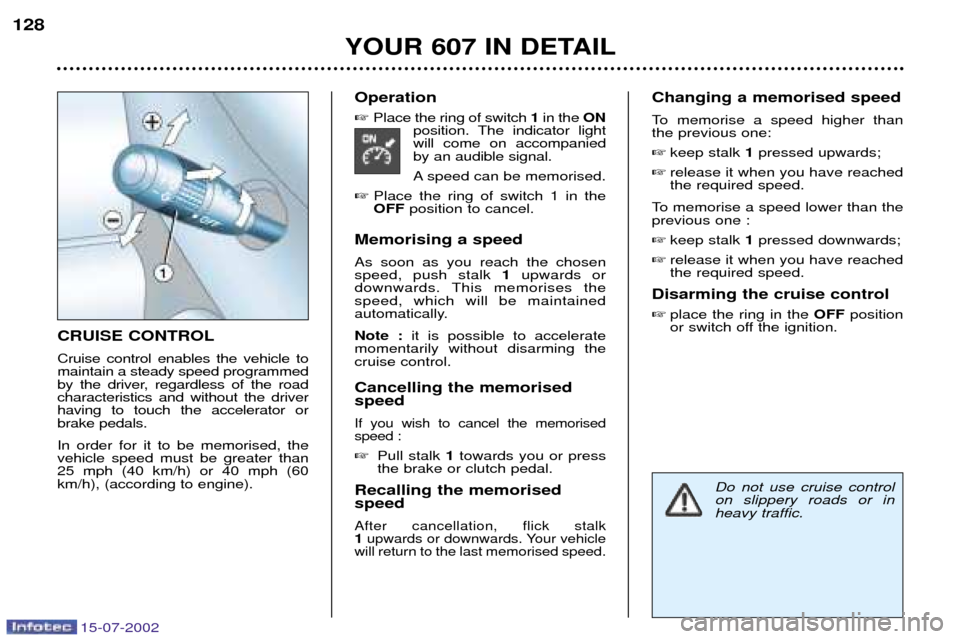Page 129 of 171

15-07-2002
Notes It is only possible to change from one gear to another if the vehicle speed and enginespeed permit. If they do not, the vehicle willoperate temporarily in automatic mode. When the vehicle is stationary or moving
very slowly, the gearbox automaticallyselects gear M1.
Programmes S(sport) and �(snow) do not
operate in manual mode.
Operating abnormality Any operating abnormality isshown by illumination of this warn-ing light, accompanied by an audi-ble signal and the message 'Auto-
matic gearbox faulty' on the
multi-function display. In this situation the gearbox operates in
downgrade mode (locked in 3rd gear). Youmay feel a substantial knock when selectingreverse from Pto Rand from Nto R(this will
not cause any damage to the gearbox). Do not exceed 60 mph (100 km/h).
Contact a PEUGEOT dealer as soon as possible.Automatic operation Automatic changing of the four gears:
�select function Din the gate.
The gearbox always selects the most suitable gear according to the follow-ing parameters:
Ð the style of driving,
Ð the road profile,
Ð the vehicle load.The gearbox is then operating in auto- adaptive mode, without any action onyour part.
WARNING Never select function N when the vehi-
cle is moving.Never select functions Por Runless
the vehicle is stationary.Never change betwen functions to optimise braking on a slippery surface. Notes For immediate maximum acceleration
without touching the gear lever, pressthe accelerator pedal down as far as it
will go (kickdown). The gearbox willautomatically change down or main-tain the gear selected until maximumengine speed is reached. When the brake is applied, the gear- box will automatically change down in
order to provide efficient engine brak-ing.
If you take your foot off the accelerator
suddenly, the gearbox will not change
to a higher gear for reasons of safety. Sport and snow programmes In addition to the auto-adaptive pro- gramme, there are two special pro-grammes.The programme is displayed on theinstrument panel screen. Sport programme
�Press button
Sonce the vehicle has
been started and function Dselected.
The gearbox automatically favours sporty driving and more dynamicacceleration. Snow programme This programme improves starting and
drive when traction is poor.
�Press button �once the vehicle has
been started and function Dselected.
The gearbox adapts to driving on slip-pery roads. Note: you can return to the auto-adap-
tive programme at any time.
�Press button Sor �again to switch
off the programme you are in.
Manual operationManual changing of the four gears:
�select function Min the gate,
�push the lever to the +sign to
change to a higher gear,
�pull the lever to the -sign to change
to a lower gear.
You can change from position D(dri-
ving in automatic mode) to position M
(driving in manual mode) at any time.
YOUR 607 IN DETAIL
124
If the battery is flat and the lever is in position
P, it will
be impossible to changeto another position.
Page 130 of 171

15-07-2002
YOUR 607 IN DETAIL125
EMERGENCY BRAKING
ASSISTANCE SYSTEM
In an emergency, this system enables the optimum braking pres-
sure to be reached more quickly,thus reducing the stopping distance. It is triggered according to the speed
of activation of the brake pedal. The
effect of this is a reduction in theresistance of the pedal and an
increase in braking efficiency.
ABS ANTI-LOCK BRAKING SYSTEM
The ABS with Electronic Brake Force Distribution (EBFD) increases the sta-bility and manoeuvrability of yourvehicle, particularly on poor or slip-pery road surfaces. Note:
when changing wheels (tyres
and rims), make sure that these are approved. The anti-lock braking system comes into operation automatically whenthere is a risk of wheel lock.
Illumination of this warninglight, accompanied by anaudible signal and the mes-sage "Braking fault" on the
multi-function display, indi-
cates a malfunction of the electronicbrake force distribution, which cancause a loss of control of the vehiclewhen braking.
Stop immediately.
Contact a PEUGEOT dealer.
Normal operation of the ABS may make itself felt by slight vibrationsof the brake pedal. In emergency braking, press very firmly without releasingthe pressure.
MANUAL GEARBOX Reverse
To change to reverse gear, lift the ring under the gear lever knob andpush the gear lever to the left then tothe front. Reverse gear can only be engaged when the vehicle is stationary withthe engine idling.
Page 131 of 171

15-07-2002
YOUR 607 IN DETAIL127
ELECTRONICALLY CONTROLLED SUSPENSION The suspension adapts automatical- ly and instantly to different drivingstyles and road characteristics,improving the comfort of the occu-pants and the vehicle's road holdingcapabilities. The suspension favours smooth shock absorption, ensuring a com-fortable ride, but as soon as condi-tions demand a change (sporty dri-ving, tight bends, avoidance action,etc.) it automatically selects firmershock absorption, guaranteeing opti-mum road holding.Selecting the SPORT position
� Press switch 1, the SPORT indi-
cator light will come on,accompanied by an audiblesignal. In this position, the suspen- sion is maintained in the
SPORT position.
To return to automatic opera-tion
� Press switch 1again. The indicator
light will go out and the
AUTO indicator light comes
on, accompanied by an audi-ble signal.
Operating check This is confirmed by the switch light
and the indicator lights. The switchlight comes on for approximatelythree seconds every time the ignitionis switched on. If the switch light flashes or if the indicator light comes on, accompa-nied by an audible signal and themessage ' Hydraulic suspension
pressure insufficient' , contact your
PEUGEOT dealer.
HANDBRAKE ApplyingWhen parking, pull the handbrake to immobilise your vehicle.
Warning: when parking on a slope,
direct your wheels towards the pave- ment and apply the handbrake. ReleasingPull the handle and press the button to release the handbrake.
Page 132 of 171

15-07-2002
YOUR 607 IN DETAIL
126
Operating check
When a malfunction of the sys- tems occurs, the switch lightflashes and the warning lightcomes on, accompanied by anaudible signal and the mes-
sage 'ESP/ASR system faulty' on the
multi-function display.
Contact a PEUGEOT dealer to have the system checked.
Disarming the ASR/ESP systems In exceptional conditions (starting a vehicle which is bogged down, stuck
in snow, on soft ground...), it may be
advisable to disarm the ASR system,so that the wheels can move freelyand regain grip.
�Press the 'ESP OFF'
switch, located under thesteering wheel to the left.
The switch lights up and thewarning light comes on,accompanied by an audiblesignal and the message
'ASR/ESP system de-acti-vated' on the multiÐfunction
display : the ASR and ESP systems
no longer have any effect on theengine operation. These are triggered again :
� automatically if the ignition is
switched off,
� manually by pressing the switchagain.DYNAMIC STABILITY
CONTROL (ESP) AND
TRACTION CONTROL (ASR) These systems are linked and com-
plementary to the ABS system. In the event of a significant variation between the trajectory of the vehicle
and the path required by the driver,
the ESP system acts automaticallyon the engine and on the brake ofone or more wheels, to put the vehi-cle back on course. The traction control (ASR) system optimises drive, in order to avoid thewheels slipping, by acting on thebrakes of the drive wheels and onthe engine. It also enables the direc-tional stability of the vehicle to beimproved during acceleration. Operation of the ESP
and ASR systems
When one of the two sys-tems is in operation, thisindicator light flashes.
The ESP system offers exceptional safety in nor-mal driving, but this shouldnot encourage the driver totake extra risks or drive at
high speed. The correct functioning of this sys- tem depends on observation of themanufacturer's recommendationsregarding wheels (tyres and rims),the braking components and theelectronic components, as well asthe PEUGEOT assembly andoperation procedures. After an impact, have the system checked by a PEUGEOT dealer
Page 133 of 171

15-07-2002
YOUR 607 IN DETAIL
128
CRUISE CONTROL Cruise control enables the vehicle to maintain a steady speed programmed
by the driver, regardless of the roadcharacteristics and without the driverhaving to touch the accelerator orbrake pedals. In order for it to be memorised, the vehicle speed must be greater than25 mph (40 km/h) or 40 mph (60km/h), (according to engine). Operation
� Place the ring of switch 1in the ON
position. The indicator lightwill come on accompaniedby an audible signal.
A speed can be memorised.
� Place the ring of switch 1 in the OFF position to cancel.
Memorising a speed As soon as you reach the chosen speed, push stalk 1upwards or
downwards. This memorises thespeed, which will be maintained
automatically. Note : it is possible to accelerate
momentarily without disarming the cruise control. Cancelling the memorised speed
If you wish to cancel the memorisedspeed :
� Pull stalk 1towards you or press
the brake or clutch pedal.
Recalling the memorisedspeed
After cancellation, flick stalk 1 upwards or downwards. Your vehicle
will return to the last memorised speed.
Changing a memorised speed
To memorise a speed higher than the previous one:
� keep stalk 1pressed upwards;
� release it when you have reachedthe required speed.
To memorise a speed lower than theprevious one : � keep stalk 1pressed downwards;
� release it when you have reachedthe required speed.
Disarming the cruise control � place the ring in the OFFposition
or switch off the ignition.
Do not use cruise control on slippery roads or inheavy traffic.
Page 134 of 171

15-07-2002
YOUR 607 IN DETAIL129
If there is an operating fault, the audible signal willbe a short bleep followedby a long bleep when
changing to reverse gear.
REAR PARKING ASSISTANCE
This system consists of four proximity
sensors, located in the rear bumper,and a special speaker fitted under therear parcel shelf. It detects any obstacle (person, vehicle, tree, gate, pavement etc.) behind thevehicle. Note:
this function will be disarmed
when the vehicle is towing a trailer (vehicle fitted with towing attachmentrecommended by PEUGEOT). In win-
ter, ensure that the sensors are not
covered with frost or snow.
Activation The system is activated as soon as reverse gear is engaged; an audiblebleep shows that it is active. An audible signal indicates the prox-
imity of the obstacle. This signalbecomes more rapid as the vehicleapproaches the obstacle. When the distance between the rear of the vehicle and the obstacle isless than approximately twenty-fivecentimetres, the audible signalbecomes continuous. Deactivation
� Change to neutral, the system
becomes inactive.
Detection zone
Page 135 of 171

15-07-2002
FRONT AIR BAGS These are folded in the centre of the steering wheel for the driver and in
the fascia for the front passenger.
They are deployed simultaneously,except in cases where the air bag isdisarmed. Front air bag malfunctionIf this warning light comes on, accompanied by abuzzer and the message"Air bag fault" on the multi-
function display, contact a
PEUGEOT dealer to have the sys-tem checked.
YOUR 607 IN DETAIL
130
AIR BAGS The air bags have been designed to maximise the safety of the occupantsin the event of serious collisions;they work in conjunction with theforce limiting seat belts. In the event of a serious collision, the electronic detectors record andanalyse any abrupt deceleration ofthe vehicle: if the triggering thresholdis reached, the air bags inflateinstantly and protect the occupantsof the vehicle. Immediately after the impact, the air
bags deflate rapidly, so that they donot hinder the visibility of the occu-pants nor their possible exit from thevehicle. The air bags will not be deployed in collisions which are not serious, for
which the seat belt is sufficient to
provide maximum protection. Theseriousness of the collision dependson the nature of the obstacle and thespeed of the vehicle at the momentof impact. Air bags only operate when the ignition is switched on. Note: the gas escaping from the air
bags can be a minor irritant.
Disarming the passenger air bag*
To ensure the safety of your child, it is essential to disarm the pas-senger air bag when you install arear-facing child seat on the frontpassenger seat. � With the ignition switched off, insert the key into the passengerair bag disarming switch 1, turn it
to the "OFF"position, then
remove the key keeping the slotin this position. The air bag warning light on the instrument panel is lit throughoutthe disarming process.
* According to destination
Page 136 of 171

15-07-2002
YOUR 607 IN DETAIL131
In the "OFF" position, the passenger
air bag will not be triggered in the event of an impact. As soon as the child seat is removed, turn the air bag slot to the"ON" position to re-activate the air
bag and thus ensure the safety ofyour passenger in the event of animpact. Operating check This is confirmed by an indicator light, accompanied by an audible sig-nal and a message on the multi-func-
tion display.
With the ignition on (2ndnotch), illumination of thiswarning light accompaniedby an audible signal and themessage "Passenger air
bag disarmed" on the multi-function
display, indicates that the passengerair bag is disarmed (switch in the"OFF" position). SIDE AIR BAGS AND
CURTAIN AIR BAGS The side air bags are incorporated into the frame of the front seat back,on the door side. The curtain air bags are incorporated into the door pillars and the upperpart of the passenger compartment. They are deployed independently of each other depending on which sidethe collision occurs. Operating check This is confirmed by a light on the instrument panel, accompanied byan audible signal and a message on
the multiÐfunction display.
If this indicator light comes on, accompanied by anaudible signal and the mes-sage 'Air bag(s) faulty' ,
contact a PEUGEOT dealer
to have the system checked.
 1
1 2
2 3
3 4
4 5
5 6
6 7
7 8
8 9
9 10
10 11
11 12
12 13
13 14
14 15
15 16
16 17
17 18
18 19
19 20
20 21
21 22
22 23
23 24
24 25
25 26
26 27
27 28
28 29
29 30
30 31
31 32
32 33
33 34
34 35
35 36
36 37
37 38
38 39
39 40
40 41
41 42
42 43
43 44
44 45
45 46
46 47
47 48
48 49
49 50
50 51
51 52
52 53
53 54
54 55
55 56
56 57
57 58
58 59
59 60
60 61
61 62
62 63
63 64
64 65
65 66
66 67
67 68
68 69
69 70
70 71
71 72
72 73
73 74
74 75
75 76
76 77
77 78
78 79
79 80
80 81
81 82
82 83
83 84
84 85
85 86
86 87
87 88
88 89
89 90
90 91
91 92
92 93
93 94
94 95
95 96
96 97
97 98
98 99
99 100
100 101
101 102
102 103
103 104
104 105
105 106
106 107
107 108
108 109
109 110
110 111
111 112
112 113
113 114
114 115
115 116
116 117
117 118
118 119
119 120
120 121
121 122
122 123
123 124
124 125
125 126
126 127
127 128
128 129
129 130
130 131
131 132
132 133
133 134
134 135
135 136
136 137
137 138
138 139
139 140
140 141
141 142
142 143
143 144
144 145
145 146
146 147
147 148
148 149
149 150
150 151
151 152
152 153
153 154
154 155
155 156
156 157
157 158
158 159
159 160
160 161
161 162
162 163
163 164
164 165
165 166
166 167
167 168
168 169
169 170
170






